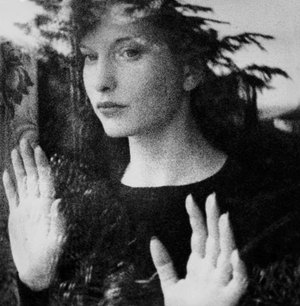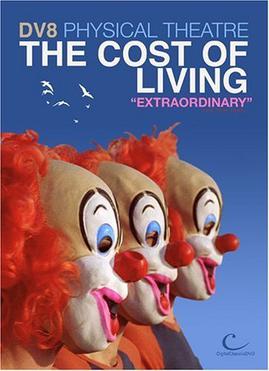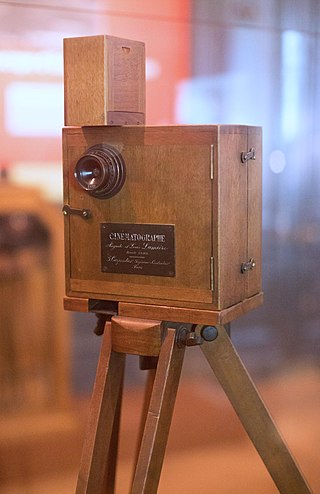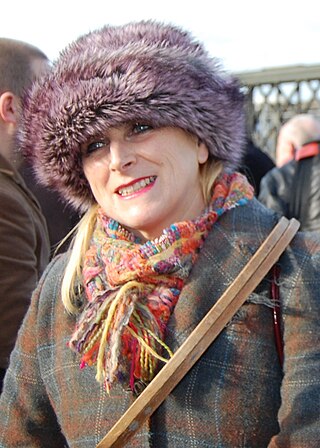
Digital cinema refers to the adoption of digital technology within the film industry to distribute or project motion pictures as opposed to the historical use of reels of motion picture film, such as 35 mm film. Whereas film reels have to be shipped to movie theaters, a digital movie can be distributed to cinemas in a number of ways: over the Internet or dedicated satellite links, or by sending hard drives or optical discs such as Blu-ray discs.

Choreography is the art or practice of designing sequences of movements of physical bodies in which motion or form or both are specified. Choreography may also refer to the design itself. A choreographer is one who creates choreographies by practising the art of choreography, a process known as choreographing. It most commonly refers to dance choreography.

Maya Deren was a Ukrainian-born American experimental filmmaker and important part of the avant-garde in the 1940s and 1950s. Deren was also a choreographer, dancer, film theorist, poet, lecturer, writer, and photographer.

Mercier Philip "Merce" Cunningham was an American dancer and choreographer who was at the forefront of American modern dance for more than 50 years. He frequently collaborated with artists of other disciplines, including musicians John Cage, David Tudor, Brian Eno, and graphic artists Robert Rauschenberg, Bruce Nauman, Andy Warhol, Roy Lichtenstein, Frank Stella, and Jasper Johns; and fashion designer Rei Kawakubo. Works that he produced with these artists had a profound impact on avant-garde art beyond the world of dance.
Visual effects is the process by which imagery is created or manipulated outside the context of a live-action shot in filmmaking and video production. The integration of live-action footage and other live-action footage or CGI elements to create realistic imagery is called VFX.

Motion capture is the process of recording the movement of objects or people. It is used in military, entertainment, sports, medical applications, and for validation of computer vision and robots. In filmmaking and video game development, it refers to recording actions of human actors and using that information to animate digital character models in 2D or 3D computer animation. When it includes face and fingers or captures subtle expressions, it is often referred to as performance capture. In many fields, motion capture is sometimes called motion tracking, but in filmmaking and games, motion tracking usually refers more to match moving.

Expressive dance from German Ausdruckstanz, is a form of artistic dance in which the individual and artistic presentation of feelings is an essential part. It emerged as a counter-movement to classical ballet at the beginning of the 20th century in Europe. Traditional ballet was perceived as austere, mechanical and tightly held in fixed and conventional forms. Other designations are modern dance and free dance, expressionist dance or new artistic dance, in Anglo-American countries German dance. In 2014, modern dance with the stylistic forms and mediation forms of rhythmic and expressive dance movements was included in the German List of intangible Cultural Heritage as defined by the UNESCO Convention for the Safeguarding of Intangible Cultural Heritage. German Expressionist dance is related to Tanztheater.
The Zap was a beach-front nightclub and performance arts venue, in Brighton, England that became known in the late 1980s and early 1990s particularly for its acid house nights. It has been described as an "influential ... club which pulled together many of the underground strands of visual art, fashion, music, design, comedy, cabaret and theatre which were circling at the time".
DV8 Physical Theatre was a physical theatre company based at Artsadmin in London, United Kingdom. It was officially founded in 1986 by Lloyd Newson (1986–2015), Michelle Richecoeur (1986–1988) and Nigel Charnock. Lloyd Newson led the company as choreographer and artistic director from its inception, apart from the production My Sex, Our Dance (1986), which was co-created and performed with Nigel Charnock. DV8 officially ended in April 2022 when Lloyd Newson announced his retirement via the company web page.

Russell Scott Maliphant is a British choreographer. He grew up in Cheltenham and trained at the Royal Ballet School and graduated into Sadler's Wells Royal Ballet before leaving to pursue a career in independent dance. As a performer Maliphant worked with companies such as DV8 Physical Theatre, Michael Clark Company, Laurie Booth Company and Rosemary Butcher. He has studied anatomy, physiology, bio-mechanics, and the Rolfing Method of Structural Integration. In April 2000, he received an Arts Council Fellowship. He has created over 20 pieces to date, collaborating closely with lighting designer Michael Hulls, and has set works on renowned companies and artists including: Lyon Opera Ballet, Ricochet Dance Company, The Batsheva Ensemble and Ballet de Lorraine.
The terms dance technology and Dance and Technology is the application of modern information technology in activities related to dance: in dance education, choreography, performance, and research.

In 3D video games, a virtual camera system aims at controlling a camera or a set of cameras to display a view of a 3D virtual world. Camera systems are used in video games where their purpose is to show the action at the best possible angle; more generally, they are used in 3D virtual worlds when a third-person view is required.

Hilde Boman-Behram was an expressionist dancer, choreographer and dance teacher whose pioneering work in integrated dance transformed modern dance.
The physically integrated dance movement is part of the disability culture movement, which recognizes and celebrates the first-person experience of disability, not as a medical model construct but as a social phenomenon, through artistic, literary, and other creative means.

The Cost of Living is a British physical theatre dance film made in 2004 by DV8 Films Ltd. and Channel 4. It is an adaptation of a stage production by DV8 Physical Theatre. Directed by Lloyd Newson, the founder of DV8 Physical Theatre, the film uses dance, dialogue and physical theatre to tell the story of two street performers and their interaction with other performers in Cromer, a seaside resort town, at the end of the summer season. The film has won a number of awards.

The history of film technology traces the development of techniques for the recording, construction and presentation of motion pictures. When the film medium came about in the 19th century, there already was a centuries old tradition of screening moving images through shadow play and the magic lantern that were very popular with audiences in many parts of the world. Especially the magic lantern influenced much of the projection technology, exhibition practices and cultural implementation of film. Between 1825 and 1840, the relevant technologies of stroboscopic animation, photography and stereoscopy were introduced. For much of the rest of the century, many engineers and inventors tried to combine all these new technologies and the much older technique of projection to create a complete illusion or a complete documentation of reality. Colour photography was usually included in these ambitions and the introduction of the phonograph in 1877 seemed to promise the addition of synchronized sound recordings. Between 1887 and 1894, the first successful short cinematographic presentations were established. The biggest popular breakthrough of the technology came in 1895 with the first projected movies that lasted longer than 10 seconds. During the first years after this breakthrough, most motion pictures lasted about 50 seconds, lacked synchronized sound and natural colour, and were mainly exhibited as novelty attractions. In the first decades of the 20th century, movies grew much longer and the medium quickly developed into one of the most important tools of communication and entertainment. The breakthrough of synchronized sound occurred at the end of the 1920s and that of full color motion picture film in the 1930s. By the start of the 21st century, physical film stock was being replaced with digital film technologies at both ends of the production chain by digital image sensors and projectors.

Ballet Pixelle is a ballet company founded in 2006 by choreographer Inarra Saarinen. Saarinen still serves as artistic director and choreographer. Ballet Pixelle is the first dance company to perform completely in virtual reality. Its goal is to explore and extend physical and virtual dance and movement and to blend those realities.
Lloyd Newson is a director, dancer and choreographer. He formed DV8 Physical Theatre and has led the company since its inception in 1986. He studied psychology and social work at Melbourne University and after graduating began his dancing career in New Zealand, initially as a dancer but later also as a choreographer.

Gilles Jobin is a Swiss dancer, choreographer and director living and working in Geneva, Switzerland.

Liz Aggiss is a British live artist, dance performer, choreographer and film maker. Her work is inspired by early 20th century Ausdruckstanz, in particular the Grotesque dance of Valeska Gert, and by British Music Hall and Variety acts such as the eccentric dance performers, Max Wall and Wilson, Keppel and Betty. She is often described as the 'grand dame of anarchic dance'.












